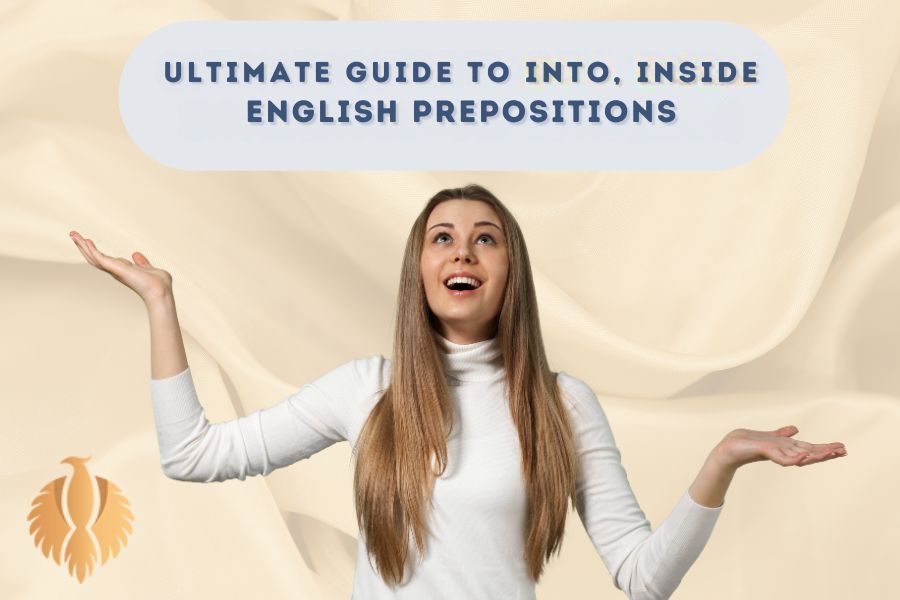Have you ever been inside your home moving from one room into another searching for your EarPods? Or have you been inside a faculty and going from one class into another searching for your professor?
Did you pay attention to the use of “inside” and “into” in these two sentences? If you still don’t know when to use “inside” and when to use “into”, follow me through this lesson to the end because I’m going to tell you all about the meaning and usage of these two very useful prepositions.
As you know, there are many more prepositions in English language. But today we are focusing on learning the usage of “inside” and “into”.
“Just give this video a shot to learn how to use ‘INSIDE’ in your sentences – it’s kinda cool and down-to-earth!”
Watch this video to learn how to use ‘INTO’ in your sentences:
Inside as a preposition
One of the main functions of “inside” is to be used as a preposition. In the following, you are going to learn different usages of “inside” as a preposition.
“Inside” as a Preposition of Place
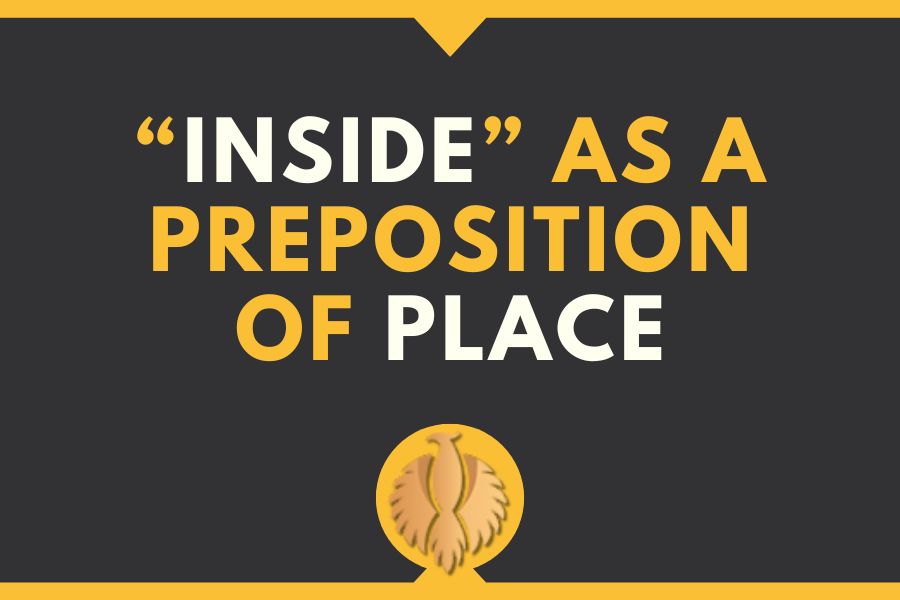
We can use “inside” as a preposition of place to show that something is in another thing/person.
Examples:
- Inside the passport was a folded slip of paper.
- Deep inside the tunnel, he found a door that led to another realm.
- Go inside the house.
- Inside the box was a gold watch.
- I could hear strange voices inside my head.
- She made a film about what life was like inside the refugee camp.
- You’ll feel better with a good meal inside you.
Learn English for free and have fun with me!: Have Vs Had: Complete Grammatical Guide [2023 Method]
“Inside” as a Preposition of Time
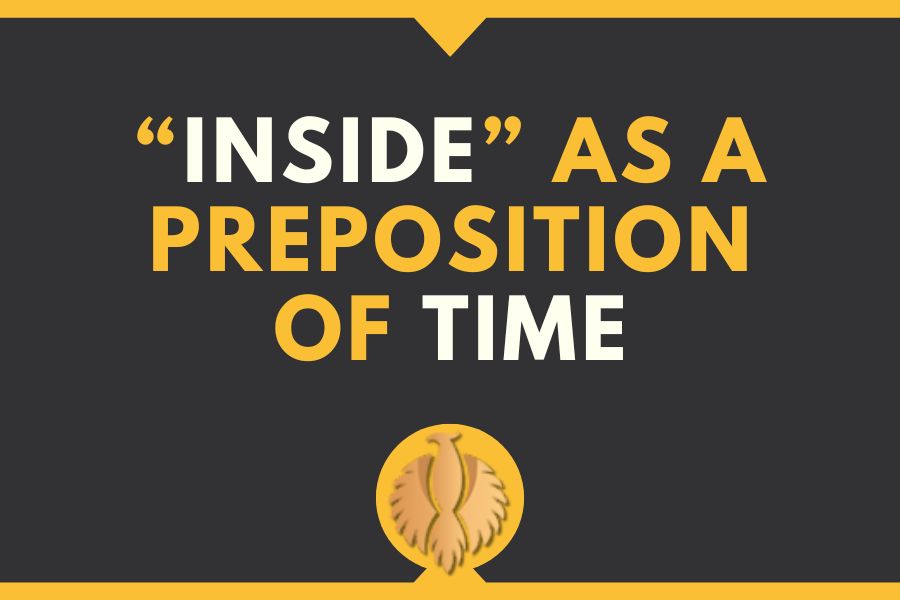
We can also use “inside” as a preposition of time to show that something will or will not be done in less than the time mentioned.
Examples:
- If you practice an hour every day, you can be a vocalist inside (of) a year.
- I don’t think we will be able to finfish this whole project inside (of) a month.
- They should get everything working inside an hour.
Position of “inside” as a preposition in a Sentence
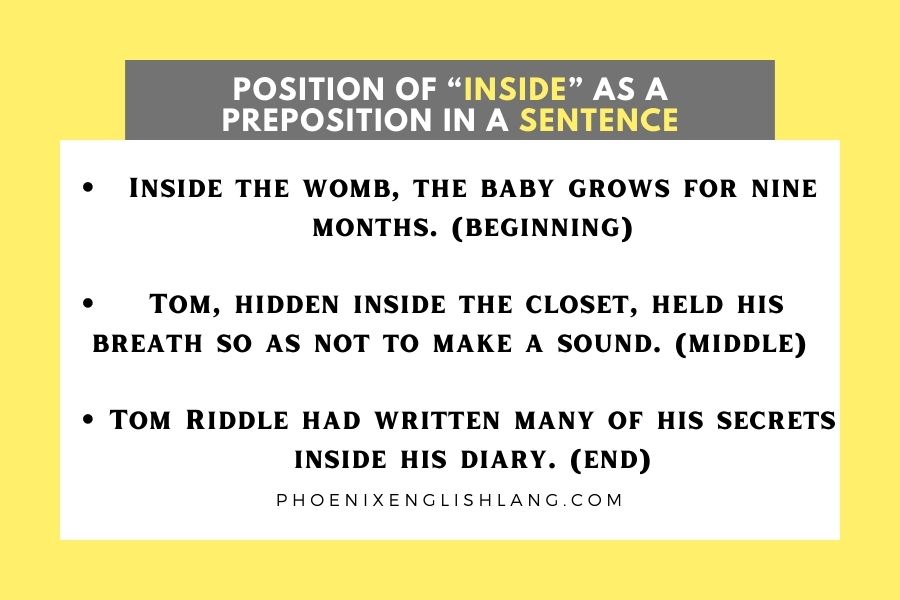
Prepositions mainly come before nouns and noun phrases to modify them. These noun phrases can be located at the beginning, in the middle, or at the end of a sentence.
Examples:
- Inside the womb, the baby grows for nine months. (beginning)
- Tom, hidden inside the closet, held his breath so as not to make a sound. (middle)
- Tom Riddle had written many of his secrets inside his diary. (end)
Note: whenever there is a prepositional phrase at the beginning of the sentence, it must always be followed by a comma. If it is in the middle, it must be put between two commas.
“Inside” as a Noun
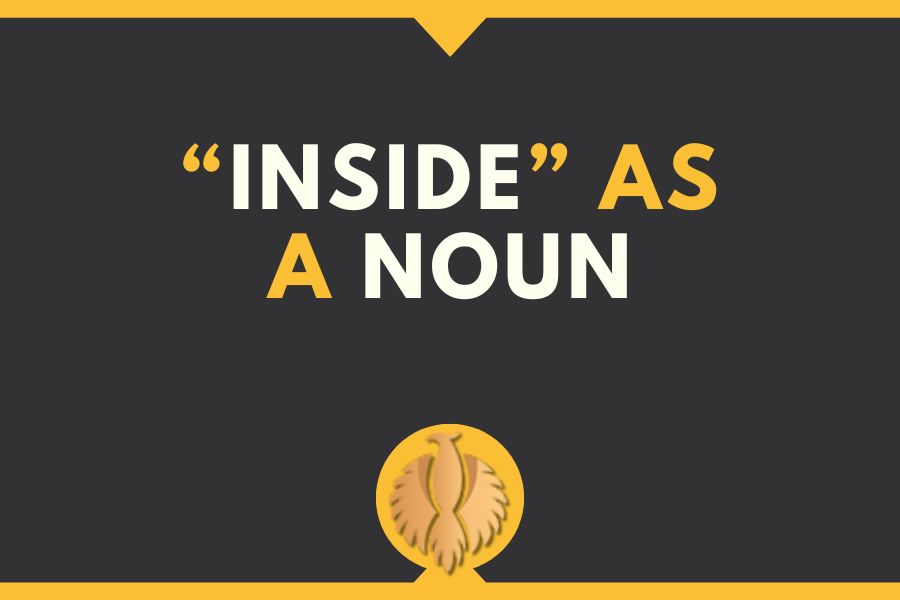
“Inside” can be used as a noun. When we want to refer to the internal part of something, we use “inside”.
Examples:
- The inside of the package was all muddy and dirty.
- The cake is all blue and the inside consists of walnuts and chocolate chips.
- The doors were locked from the inside.
We can also use “inside” to mention the inner side or surface of something.
Examples:
- She looked at the inside of her hand.
- He pinned the money to the inside of his jacket
We can use “inside” in the plural form to refer to the internal organs.
Examples:
- Every pill made my insides turn upside down.
- She went to see a doctor in order to do something about the pain in her insides.
Learn English for free and have fun with me!: Only Vs Just All You Need to Know + Examples
Position of “inside” as a noun in a Sentence
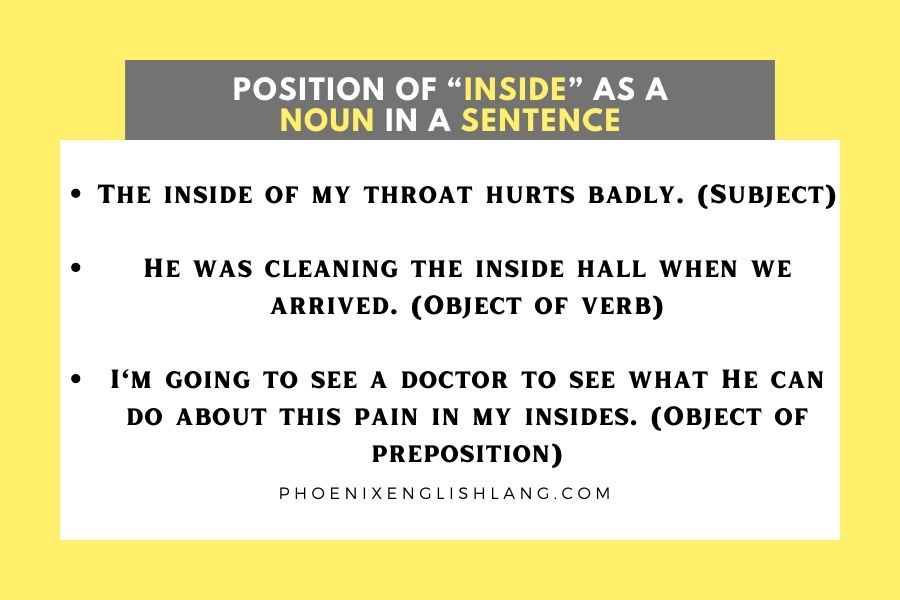
As you know, nouns can be the subject, the object of a verb, or the object of a preposition.
Examples:
- The inside of my throat hurts badly. (Subject)
- He was cleaning the inside hall when we arrived. (Object of verb)
- I’m going to see a doctor to see what He can do about this pain in my insides. (Object of preposition)
“Inside” as an adjective
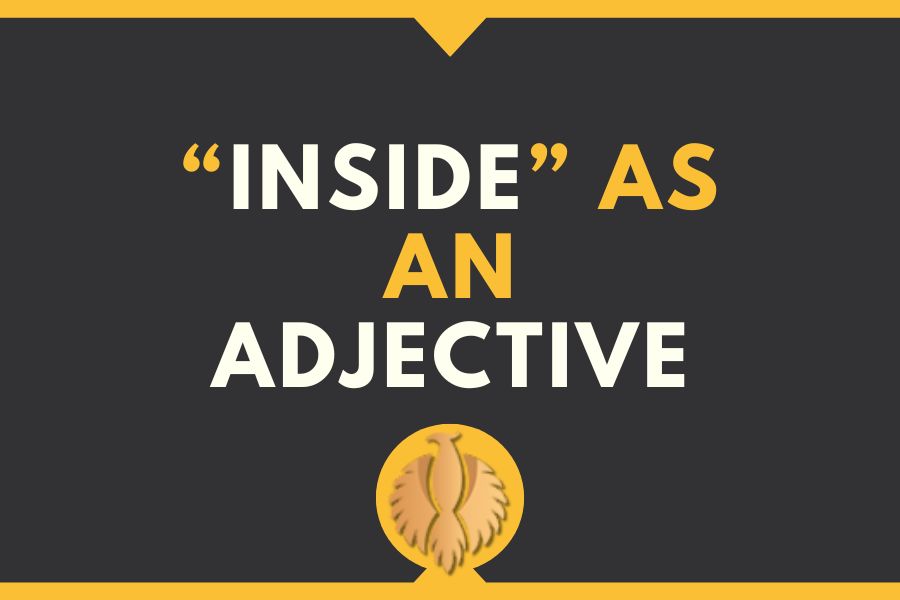
“Inside” can be used as an adjective. As you know, adjectives come before nouns.
Examples:
- She showed me the inside hall where they had had supper earlier.
- These trousers also have big, handy inside pockets.
- He pulled out a pack of cigarettes from his left inside pocket.
- The inside pages of this magazine have nothing interesting for me.
“Inside” as an Adverb
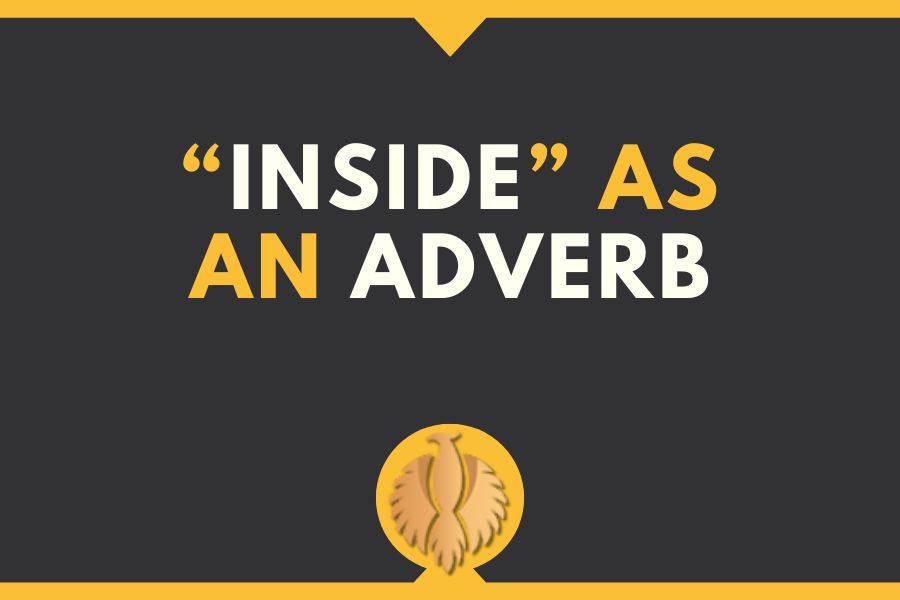
“Inside”’ can also be used as an adverb of place to say that someone is in a particular place or area.
Examples:
- Jeremy said he had heard a loud cry from inside.
- Although she pretended not to care, she was deeply hurt inside.
- Please go inside.
- Didn’t I tell you to stay inside?
- Inside most of us is a small child screaming for attention. (figurative)
- We can also use “inside” to show that someone is in prison.
Examples:
- They’ve both done prison time – he’s been inside three times.
- They were inside for five years.
- “Inside” can also be used to mean “indoors”.
Examples:
- They play inside on rainy days.
- It was windy out there, so we decided to spend our time inside watching movies.
Learn English for free and have fun with me!: I Have No Clue [Meaning + Examples]- All You Need To Know!
Position of “inside” as an adverb in a Sentence
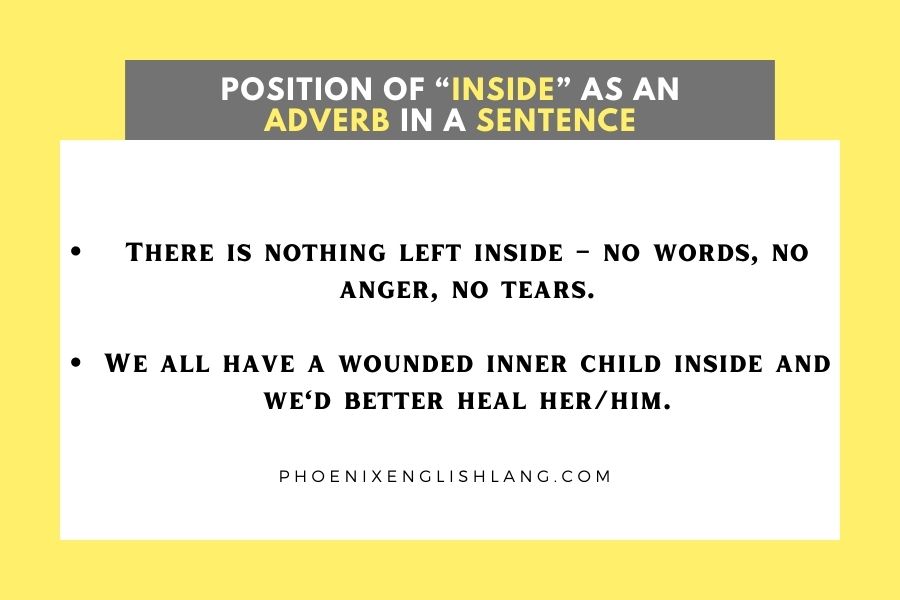
Adverbs mainly comes after adjectives, verbs, and other adverbs to modify them.
Examples:
- There is nothing left inside – no words, no anger, no tears.
- We all have a wounded inner child inside and we’d better heal her/him.
“Into” as a preposition
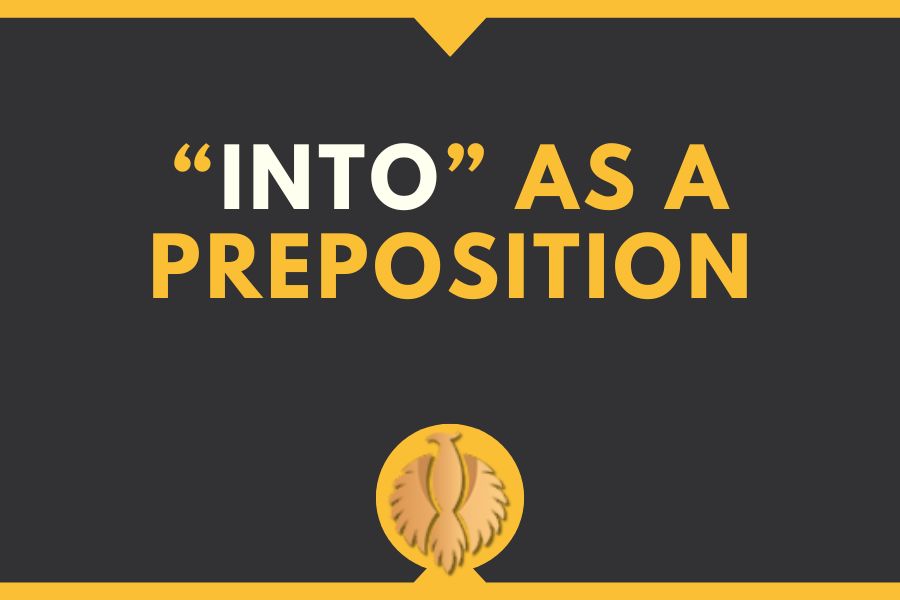
“Into” is a preposition which can be used to convey different meanings. In the following, I’m going to tell you its different usages.
“Into” can be used to convey the meaning of “to a position in or inside something”. If you put one thing into another, you put the first thing inside the second.
Examples:
- She dived into the water.
- Come into the house.
- Combine the remaining ingredients and put them into a dish.
- He threw the letter into the fire.
- She turned and walked off into the night. (figurative)
- Until the 1980s almost all olives were packed into jars by hand.
“Into” can be used to mean “in the direction of something”.
Examples:
- Driving into the sun, we had to shade our eyes.
- Speak clearly into the microphone.
- “Into” is also used when we want to mention “a movement”. If you go into a place
- or vehicle, you move from being outside it to being inside it.
Examples:
- She got up and went into an inner office.
- I have no idea how he got into Iraq.
- He got into bed and started to read.
If one thing goes into another, the first thing moves from the outside to the inside of the second thing, by breaking or damaging the surface of it.
Examples:
- Flavell had accidentally discharged a pistol, firing it into the ceiling.
- rider came off and the handlebar went into his neck.
If one thing gets into another, the first thing enters the second and becomes part of it.
Examples:
- Poisonous smoke had got into the water supply.
- The money went into a common fund
We can use “into” to convey “a change in state” of something.
Examples:
- Can you translate this passage into German?
- The fruit can be made into jam.
- She was sliding into depression.
- They came into power in 2008.
Learn English for free and have fun with me!: Main Difference Between Carefree and Careless
If something changes into something else, it then has a new form, shape, or nature.
Examples:
- She is learning what she needs to know to grow into a competent adult.
- I love Irish fairy tales that have been translated into English.
- His attempt to turn a nasty episode into a joke was fruitless.
If someone or something gets into a particular state, they start being in that state.
He had too much time on his hands and that caused him to get into trouble.
Examples:
- The group plunged into financial crisis earlier in the year.
- They slid into a depression.
We can use “into” to talk about persuasion. If you “talk someone into doing something” you persuade them to do it.
Examples:
- They tried to talk me into selling my house.
- Gerome tried to talk her into taking an apartment in Paris.
“Into” can also mean “to a point at which you hit somebody/something”. If you are walking or driving a vehicle and you “bump into” something or “crash into” something, you hit it accidentally.
Examples:
- The truck crashed into a parked car.
- A train plowed into the barrier at the end of the platform.
- While looking on her phone, she almost crashed into a tree.
- Joanna heard him bump into the table and curse again.
We use “into” for wearing clothes too. When you “get into” a piece of clothing, you put it on.
Examples:
- He put on his underwear and got into his suit.
- She could change into a different outfit in two minutes.
We can use “into” to “show the result of an action”.
Examples:
- He was shocked into a confession of guilt.
- We were stunned into admiration at seeing the glory of the palace.
To convey the meaning of “about or in connection with something” we use “into” as well. An investigation into a subject or event is concerned with that subject or event.
Examples:
- The concert will raise funds for research into lung cancer.
- She made an inquiry into safety procedures.
- We are beginning to have some insight into drug therapy.
“Into” is used to mention “the start of a particular career or business”.
Examples:
- He closed down the business and went into politics.
- In the early 1990s, it was easy to get into the rental business.
“Into” can also be used to convey the meaning of “to a point during a period of time”.
Examples:
- He didn’t get married until he was well into his forties.
- She carried on working late into the night.
If something continues into a period of time, it continues until after that period of time has begun.
Examples:
- The Open Golf Championship will be getting into its second day in a few hours.
- He had three children, and lived on into his sixties.
“Into” is also used when you are “dividing numbers”.
Examples:
- 3 into 24 is 8.
- 4 into 100 equals 25.
- If something is cut or split into a number of pieces or sections, it is divided so that
- it becomes several smaller pieces or sections.
Learn English for free and have fun with me!: Top 70 Most Used Words Ending in “Less”
Examples:
- Now if a great lake like Victoria were to dry up partially, it would be split into a
- number of separate, smaller lakes.
- Roll out the pastry and cut into narrow strips.
- Sixteen teams are taking part, divided into four groups.
We can also use “into” to express our passions. If you are very interested in something and like it very much, you can say that you are into it.
Examples:
- I’m into electronics myself.
- His father was into the hobby of collecting coins from different eras.
- He’s into surfing in a big way.
Note: Remember that this usage is informal and can also be considered idiomatic.
Concluding Note
As a final note, let me give you a brief explanation about “prepositions” in English. A preposition is a small but very common word or group of words that relates different parts of speech to each other.
Most English prepositions have a number of meanings. Simple prepositions consist of one word; for example, “in, on, under”.
Complex prepositions consist of more than one word; for example, “due to, together with, on top of, in spite of, out of”. Prepositions are used mainly for the following purposes:
to express movement to or from a place
to express location and time
I hope that this lesson about the prepositions “inside” and “into” will be of use to you.
I might tell you about other prepositions in English language in future lessons. Try making sentences with these two prepositions to learn them better. Visit my page for more interesting English lessons.

Hi, welcome to my blog! My name is Omid and I am thrilled to have you here! I am an English language teacher with 12 years of experience and hold multiple international certifications (TESOL, IELTS, TOEFL, PTE, CELTA). Additionally, I hold a PhD in Applied Linguistics with a specialization in Teaching English as a Second Language (TESL), which fuels my passion for teaching English and assisting others in mastering the language. To me, nothing is more rewarding than helping individuals enhance their English language abilities through various methods. So, let’s embark on this journey of learning English together.

